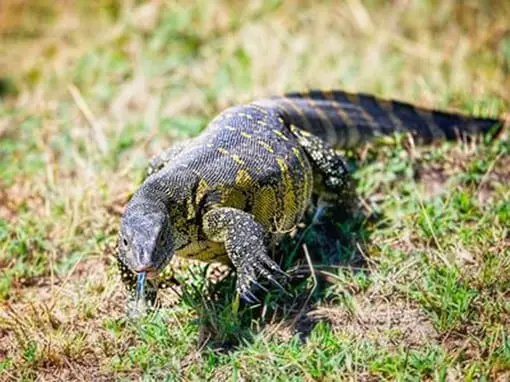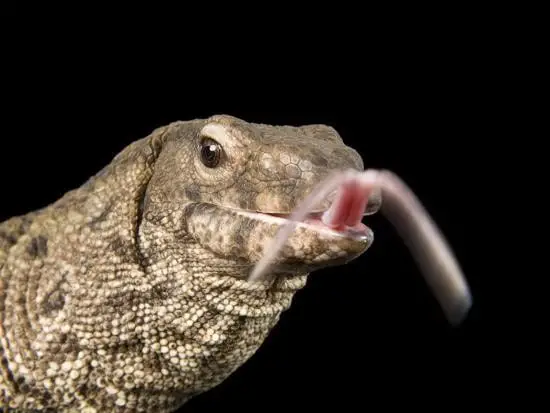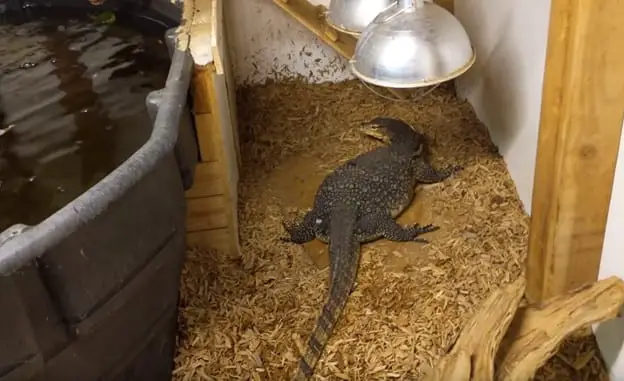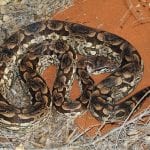Scientific Facts
| Common Name: | Dumeril’s Monitor |
| Scientific Name: | Varanus dumerilii |
| Life Span: | 8 to 12 years |
| Size: | 3 to 4 feet average but can reach up to 5 feet |
| Habitat: | Forests, swamp, and semi-aquatic areas |
| Country of Origin: | Indochina, Indonesia, Malaysia |
Physical Description

One of the largest lizard found in Southeast Asia, Dumeril’s monitor has become a very popular pet in both the USA and Europe. Because of trade and breeding limitations, obtaining these amazing lizards can be quite challenging. It’s also important to note that these lizards are often found in protected areas. Because of these, there are both researchers and scientists who don’t have enough data whether this species is rare or just extremely secretive. It’s a study and heavily built lizard that finds shelters in tropical trees. They also love living close to semi-aquatic areas such as swamps. Although there are also reports of lizard sightings on seashores.
The average size of these lizards is between 3 to 4 feet. However, there are reports where people have reared and measured a maximum total length of at least 5 feet. These lizards are frequently found in swamps where they swim, soak, and even sleep. Adult lizards are known for their beautiful marks and various shades of color. You can find lizards that have brown to tan skin. Even by monitor lizard standards, the claws of Dumeril’s monitor are extremely sharp.
As the egg hatches, youngsters that have fluorescent to orange skin emerges and spend most of their time buried underneath soft ground or soil. Their pattern and coloration then slowly become more inconspicuous as they reach their adult years.
If you’re planning to keep these beautiful creatures, then you must provide them large water containers. You should also make sure that you provide them burrowers and climbers. Replicating their natural habitat is crucial if you want to keep them happy and healthy. Also, these lizards are known to submerged underwater for up to 75 minutes, and so don’t be surprised if you find them resting below water for more than an hour.
Apart from soaking underwater, these lizards also love climbing on tree branches. They also love digging and basking. They require a temperature that ranges between 82 and 90 degrees Fahrenheit. Providing them a warmer basking site inside the enclosure is recommended, and the temperature should be maintained between 95 to 97F. Dropping the temperature during night time is also necessary, and it should be lowered down to around 70 to 75F. This is why a thermal gradient is essential if you want to rear these lizards.
Lifespan
These lizards are mostly found in Southeast Asia, like Malaysia and Indonesia. However, they can range extends to southern Thailand and Myanmar. Singapore also had these lizards many years ago, but there have been no reported sightings ever since the 1940s. They inhabit swamp forests and lowland forests. There are also reports where these lizards where caught soaking and swimming in coastal mangrove swamps. It’s also common to see these lizards live in villages and farm outskirts. In the wild, these lizards can live a maximum lifespan of 10 years. However, in captivity, their survival can extend to more than 12 years – provided that proper environment and outstanding nourishment is given.
Eating Habits
Research about the eating habits of these rare lizards is quite limited. There are a few scattered observations that said that they love to forage during night time. Although nocturnal foraging is quite natural for these lizards, they are primarily diurnal. They primarily consume insects and snails. The lizard can also be, at times, highly arboreal. Most of the time though, they are found foraging on the ground and even in shallow swamps and rivers. It also preys on snakes and small lizards. And in captivity, keepers can give them rodents and snakes occasionally.

Sleeping Habits
Just like other monitor lizards, the Dumeril’s monitor also requires rest and sleep. They love to sleep on top of tree branches and even sleep in the mater. As stated earlier, these lizards can soak, sleep, and submerged underwater for about 75 minutes. These are diurnal species, which means that they are most active during the day, although nocturnal foraging is also natural. It’s common for them to find shelter and enjoy sleep. Their movements in the wild are to either find prey or find shelter to bask or escape from the heat or sleep.
Development and Reproduction
Breeding these lizards in captivity can be quite challenging because there are not even studies and research about their development and reproduction in the wild. Nonetheless, breeding them is possible. These lizards develop-eggs, just like any other lizard. Their eggs contain considerable amounts of the yoke, which provides nourishment for the emerging hatchlings. There are not enough studies today that can tell us whether or not these lizards stay after their hatchling emerges or abandon them. However, in captivity, you must remain vigilant because there’s a great possibility that the female lizard will eat its eggs.
During mating, the male lizard will clamp their jaws on the rear leg of the female lizard. Both the male and female will then slide and adjust their bodies underneath to copulate. The mating can last for a few minutes and even up to an hour. The eggs of these lizards are leathery and tough. In most cases, males and females will not take care of their hatchlings, and thus, they have to fend for themselves.

How to Breed

The first step to successful Dumeril’s monitor breeding is to provide them a safe and healthy enclosure. The cage or enclosure should be large enough for both the male and female. It’s also possible to house a single male with 1 or 2 females. However, close monitoring is necessary to avoid fighting and injury. It’s also critical that you ensure that the container or nesting area is enclosed. You can use a wooden box or plastic storage container. Place at least 2 to 3 feet of a slightly moist mix of soil, sand, and peat moss. There’s a lot more learn about Dumeril’s monitor captive reproduction, and there are different breeders who have different success and failure reports. What is important is that you provide the optimal environmental conditions. Replicate their natural habitat as much as possible.
Common Health Problems
Monitor lizards are prone to common health problems, especially in captivity. Therefore, the keeper must make sure that he or she can determine signs and symptoms of health issues to avoid the death of the pet. Here are some of the common health problems that your Durmeril’s monitor might encounter while in captivity.
Burns and Injuries
Providing them light and heat source is necessary. However, there are instances when your pet gets too close to the heat source. As a result, your pet suffers from burns. You can treat minor burns with antiseptic ointment or wash it with soapy water. But if the burn is too severe, then it’s time for you to send them to the nearest veterinarian. Also, to prevent burns, you must keep all the light and heat sources away from the reach of your beloved pet. Cuts and scrapes can also be treated with antiseptic ointment.
Calcium Deficiency and Over-Supplementation
Metabolic bone disease or MBD is a common health problem for all reptiles. Therefore, providing them proper supplementation is crucial. You should include calcium and vitamin D3 on their diet. However, you also have to avoid supplementation. Too much calcium and vitamin D3 can lead to hypercalcemia. Too much calcium in the blood can lead to other health problems and can even result in death. You must monitor their diet and supplementation. Give them a pinch of these supplements a couple of weed. By providing them the right diet and supplementation, your pet will live a healthy life and will avoid lethargy, swollen jaws, deformities, constipation, and softening of bones.
Shedding
It’s natural for these lizards to shed as they grow; however, patches of a leftover shed can be problematic. And incomplete shedding can cause irritation and discomfort to your beloved pets. Monitor how they shed, and if you think that they’re having problems with the process, then mist them with water or give them a warm bet to aid proper and healthy shedding.
Respiratory Infection
Infections can cause great stress to your pet. This can lead to loss of appetite, swelling in specific parts of the body, and even abscess. A common respiratory infection symptom is sneezing and shallow breathing. This happens when the enclosure or habitat becomes too cold or too dam for them. To avoid this, you have to make sure that you closely monitor the temperature. Internal and external parasites can also be the cause of these infections. It’s recommended that you send your pet to the vet at least once or twice a year.
Broken Tail, Toes, and Claws
If your lizard has accidentally broken or injured his tail, toes, or close, then don’t panic. The tail will regenerate. However, when it comes to broken claws, if you want to avoid this health problem, you should regularly trim it using nail clippers. Be very careful, though, not to cut the claws too deep. Make sure that you avoid any blood vessels. If the injury is too severe, then the best thing that you can do is to send your pet to a reputable veterinarian.
Constipation
Unlike other animals, these lizards do not pass waste at regular intervals. Their system depends heavily on the temperature around them. If the environment is too cold, it’s most likely that your pet will not be able to pass waste and will have trouble digesting their foods. Impaction or blockage can lead to constipation, and this can lead to other health problems such as lethargy, loss of appetite, and even dehydration. Provide your lizard with clean and fresh water. Remember to provide the right temperature as well.
Preventing Illnesses
To prevent these common health problems, you must give them a healthy environment all the time. Examining their physical appearance is also crucial. You should also look for signs of any lethargy or weakness. A good indication of poor health is loss of appetite. Feed your pet with the right meal and make sure that you give them supplementation as well. Keep the enclosure clean all the time and change the water regularly. Asking for tips and pieces of advice from other keepers is also a good idea if you want to become a better keeper yourself. And of course, don’t forget how important it is to go and visit the vet from time to time. A yearly checkup or examination can be very helpful in keeping your pet happy and healthy.
Behavior
Dumeril’s monitor is not recommended for novices but advanced level keepers. However, if you do your homework and read useful sources on how to provide proper care, then things should go well. The key to healthy captivity is to provide proper care. It’s natural for them to exhibit shyness when transferred to a new habitat or owner. You have to be very gentle with them to gain their trust. Provide them a large and well-furnished cage where they can enjoy privacy and security. Once the monitor lizard recognizes you as their owner, then be surprised at how approachable these lizards are.
You have to be very careful, though, when approaching these lizards since they have very powerful jaws, sharp claps, and long tails that can whip. Even if your lizard is already tamed, you have to remain vigilant and try to remain vigilant when handling them. These lizards can be aggressive, especially if they are from the wild. Remember that their claws can leave deep scratches.
Habitat
Housing
It’s recommended that you place them in an enclosure that is large and spacious. Remember that these lizards can grow up to 5 feet long. Therefore, the enclosure must be large enough for them to enjoy happy captivity. There are some keepers out there who provide space for their lizards that are as small as a bedroom. You can also construct cages or enclosure that are made out of wood and plexiglass. You have to have a dedicated space for these monitors. Make sure as well that you provide them an area where they can bask – humidity should reach about 80%.
Aside from installing a basking area, it’s also essential that you place a hide box inside the enclosure. It’s their nature to hide and burrow/ Also, don’t forget to place a water area where the lizard can climb and defecate. It’s also recommended that the enclosure doesn’t have any sharp items or areas where they can get stuck. The enclosure can measure at least 6x4x6 feet.
Substrate
You can use cypress mulch, eucalyptus bark, or aspen shavings for your lizard. It’s recommended, though, that you use a mixture of natural substrates to keep the moisture. The substrate should also be deep enough for them to bury themselves. And again, make sure that you maintain proper humidity levels. Misting, foggers, and dehumidifiers are essential if you want to keep the humidity at the right levels.
Lighting and Temperature
Keeping the temperature between 80 to 120F is necessary if you want to keep them healthy. You can combine night heat lights or white heat lights. Mercury vapor bulb is also recommended if you’re planning to create a larger cage or enclosure. Maintain good distance between the light and your lizards to avoid burns. It should be at least 10 to 12 inches away from where your pet is basking or sitting. You can also use ceramic heaters to control the temperature.
Diet and Feeding
You can feed your monitor lizards with roaches, crickets, crabs, and even mic. You should offer a variety of meals for your monitor while there are still young. This encourages them to eat anything that you’ll offer them. Take note that these lizards can be messy eaters, and you’ll notice some parts of the prey scattered inside the enclosure. Be sure that you clean the enclosure from time to time to avoid inviting parasites, bacteria, or fungus. In the wild, these monitors also eat snails, fish, turtle and bird eggs, bats, and other small mammals.
Also, don’t forget to add supplementation to your beloved lizards. Add ReptiCalcium or ReptiVite. If you want to avoid common health problems such as MBD or vitamin deficiencies, then make sure that you provide them calcium and vitamins. Provide them supplementations once or twice a week only. Also, you shouldn’t offer them large food items such as rats since this can cause regurgitation.
How to Care for Dumeril’s Monitor
Seasoned keepers are aware that these lizards are not meant to be handled. This is because Dumeril’s Monitor has very sharp teeth and claws. It can seriously cause injury and can leave deep scratches. Their scratches can also cause infection, which can be very harmful to your health. Also, it’s important to note that these lizards are easily agitated, which means that they should not be held for a longer period. It’s best that you just observe them instead of touching them, especially if you are a beginner.
Providing them a clean and neat environment is also crucial for their health. If this is your first time rearing Dumeril’s monitor, then we recommend that you do some little research first. Join online communities or forums where keepers like you gather and share their thoughts and ideas on how to care for these lizards. Don’t hesitate to ask relevant questions and be polite and friendly all the time.
Don’t forget how important it is for you to send your pet to the veterinarian once in a while. Even if you think that your lizard has no health problem or is completely healthy, you still have to visit the veterinarian. Remember that internal parasites can affect the health of your lizards. There are also illnesses or diseases that can be detected just by mere observation. Therefore, go to a reputable veterinarian and have your pet checked once or twice a year.
Availability – Where to Get One?
Although these lizards are rare, you can still buy them from your local stores or online shops. You can buy them at Backwater Reptiles or underground reptiles. You must double-check the reputation and the background history of the pet shop first before you buy anything from them. Also, you must check and compare different prices of these lizards. Find out as well whether or not the shop is known for shipping fit and healthy Dumeril’s monitor lizards.
FAQ Section
Is Dumeril’s Monitor dangerous?
They are easily agitated, and their claws and teeth seriously cause harm. These lizards are meant for advanced breeders. It’s also wise that you pet them for observation purposes only and not for handling.
How big can they get?
The average size of these lizards is about 3 to 4 feet, but it’s not surprising to see lizards that can grow as long as 5 feet.
Can these lizards climb walls?
Because they have long claws, climbing is very easy for them. In fact, in some countries, robbers use monitor lizards to climb walls.
Are they venomous?
Although their bite contains venom, they are not fatal to human beings. They secrete venom and can knock out smaller prey, but human beings will not die by their bite.
How long can they survive without food and water?
If the lizard is dormant, then they can survive without food and water up to 6 to 8 months.
Can they attack human beings?
These lizards are shy and are not known for attacking human beings. However, once provoked or cornered, they will try to fight and become more aggressive.
Do they recognize their owners?
Yes, especially those that are bred in captivity. You can tame these lizards, but you shouldn’t handle them regularly.
Are they smart?
Yes, Dumeril’s monitor is among the most intelligent reptiles on the planet.


